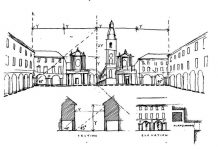Today the term “taste” is often used vaguely to mean personal preference or ephemeral fashion. But in the 18th century the term was employed in a much more focused way to indicate the specific qualities, artistic and moral, that led both to virtuous actions and good design. It was a powerful concept, and those who wielded it too enjoyed considerable power.
“‘Beauty is truth, truth beauty,’—that is all Ye know on earth, and all ye need to know.” Thus ends Keats’s “Ode on a Grecian Urn,” one of the most famous poems in English. Written in the early 19th century, the poem’s conclusion seems alien today, but in Keats’s time the equation of truth and beauty would have seemed less peculiar because they harked back to the previous century, and a set of ideas that was hugely influential on artists and thinkers. These ideas concerned the concept of taste.
Shaftesbury and beauty
The writer who first clearly defined the equation of truth with beauty was Anthony Ashley Cooper, third Earl of Shaftesbury. A member of the political classes, Shaftesbury was prevented by his health from continuing in politics so in his early thirties he turned to philosophy.
Unlike earlier philosophers, such as Thomas Hobbes, who saw mankind as preeminently selfish, Shaftesbury saw much more potential for virtue, for distinguishing between right and wrong, in humanity. Shaftesbury was also interested in aesthetics, the philosophy of the arts, and drew parallels between artistic beauty and virtue. The most radiant beauty for Shaftesbury was moral beauty, honesty, truth; but the converse for the philosophical earl was also true: artistic beauty was also morally good. As Keats would later, he equated beauty with truth, adding that beautiful architecture had true proportions.
“For all Beauty is Truth. True Features make the Beauty of a face; and true Proportions the Beauty of Architecture; as true measures that of Harmony and Musick.” Lord Shaftesbury
Taste was the ability to be able to distinguish beauty from ugliness—and also to differentiate between moral good and bad. Taste was, therefore, a crucial business, and a person who had taste was an arbiter who would be listened to with care and seriousness. Such men were often referred to as virtuosi or connoisseurs. They were expected to have all the knowledge of artistic matters that these terms imply, and to be moral arbiters, too.
The rule of taste
In the 18th century, most people believed that taste was something you were born with—anyone could read about it and understand it, but there were certain people, men of taste, who had the quality and who were marked as moral and aesthetic leaders. 18th-century writers talked about “the rule of taste”—and arbiters of taste were expected to lay down the law on the subject.
The idea that true taste could not be taught was an attractive one to aristocrats and others in privileged positions with an interest in the arts. It meant, for example, that men such as the Earl of Burlington and Henry Aldrich, Dean of Christ Church, Oxford, had the confidence to become amateur architects and became highly influential when buildings were put up to their designs.
Those designs were classical. If true, harmonious proportions produced beauty in architecture, the architects of the 18th century saw this harmony most of all in the classical architecture of the great Palladio and his followers. So they left behind the ornate and complex architecture of the baroque, with all its curves and curlicues, and turned to the chaster Palladian style, which achieved its effects through proportion and adherence to classical rules. The clear value placed on this type of harmony by Shaftesbury and others was a vital element in the 18th-century Palladian revival (see Palladianism).
Decorum
The idea of decorum was used widely by writers about the arts, and usually indicated appropriateness—choice of the appropriate style, the appropriate proportions, the appropriate ornament and so on. Under the rule of taste, the ornamental excess of the baroque style and its use of deliberately distorted proportions was seen as indecorous; the more measured and harmonious style of Palladio, as in Dean Aldrich’s work in Oxford (below), as the incarnation of decorum. In gardening, on the other hand, the rigorous symmetry of classicism was swept aside in favor of the less-formal landscape garden (see Genius loci), and this was seen as decorous because it was appropriate for gardeners to work with the curves and irregularities of nature.
Burlington, rich, powerful and convinced of his role as arbiter of taste, was the most influential of the amateur Palladians, and his work won much admiration from aristocrats generally. Aldrich, who designed buildings for his Oxford college, Christ Church, with the first-ever “palace front” in the Palladian style, was influential in church and university circles. The rule of taste pervaded the establishment.
A different taste
Horace Walpole, the disciple of Gothic architecture, was well aware of this, and perhaps happy to subvert the idea when he transformed his Twickenham house, Strawberry Hill, in mock-medieval style. Rather than employing an architect to carry out the job, he did the design himself, in collaboration with a small group of friends and associates, whom he termed his “Committee of Taste.” Such a name would have been seen as a joke on serious classicists and Palladians.
As architecture began to become more of a profession and less open to interested amateurs, taste became less important than a proper training in the basics of design and construction. But even among the professionals the idea that a true architecture is also the most beautiful held on through the 19th century, when the builders of Gothic churches declared that this style of building, as well as being admirable visually, was the most appropriate for Christianity and holiness.



















